Hedgehog can rightly be considered a universal favorite. Some of our compatriots tame even ordinary hedgehogs - this is quite possible. However, the relative fashion of recent years on domestic hedgehogs was not provoked by domestic garden vagrants, but by an artificially bred African dwarf hedgehog. But no matter which hedgehog you choose, the rules for leaving will be approximately the same, so it’s worth to understand this matter in more detail.


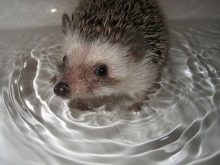
Hedgehog adaptation in the house
If you caught an ordinary hedgehog and decided to bring it home, you should not think that for him this situation is completely normal. Over time, he will get used to it, but first, having fallen into an unfamiliar environment and not having the opportunity to realize his instincts, the animal will experience significant stress. When deciding to have a needle pet, make sure to get a cage for it in advance. After catching the animal, put it in a cage and just don’t touch it on the first day - let the new pet get used to the situation and make sure that nothing bad happens to him.
It is better, of course, to take a young hedgehog, but if you do not buy a beast, you are unlikely to guess with age. Trying to accustom the baby to new conditions, pay attention to the fact that these animals have eyesight with trouble - in space they are guided, rather, by smell and memory. For this reason, experienced people recommend an unusual move, so that the beast gets used to the owner. Near the cage, you need to put your own unwashed t-shirt.
At first, the hedgehog will be afraid and curl up at every contact, but you still hold it in your hands and speak softly and gently to it. If he tries to sniff your hand - give such an opportunity, this pet gets acquainted.
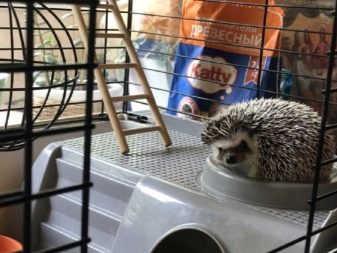

The exact timing of the adaptation of the hedgehog does not exist - it all depends on how sociable you got. Some are keenly interested in the outside world and are ready to get acquainted in a minute, which in the wild, of course, would be an obvious drawback for the animal. Incredulous animals can get used long enough, extending their acquaintance for fifteen days.
In any case, communication with the pet should be devoted at least half an hour daily - so that it gets used to it faster and no longer breaks the habit of smell.
While the baby gets used to the new environment, try not to scare him with anything. Other pets, if any, should not overlap with the hedgehog. Any loud sounds, unpredictable TV noise, high tonality of the voice of talking people and even dog barking outside the window can potentially scare him, so it is advisable to minimize all these factors, gradually accustoming the animal to the fact that all these are normal phenomena.

Conditions for keeping
A hedgehog is a moving creature and quite active, this will be confirmed by anyone who has at least once seen a beast in the wild. It means that his cell should be spacious enough not to interfere with the prisoner's walk. If you decide to keep a hedgehog in your apartment, then 70x45 cm is the minimum area of his personal territory, and it’s better to focus on a mini-aviary with dimensions of 90x60 cm. A significant height of the cage is not required, but it is advised to focus on 40 or more centimeters.
An ordinary forest hedgehog is surprisingly a wonderful treetop, because the owner will either acquire a closed-type cage, or will observe the regular shoots of his pet. Most often, for such animals, metal cages for rodents are sold, which are sold in any pet store, but you can design a wooden alternative yourself or even a plastic container with smooth slippery walls that will become an insurmountable obstacle for the baby - then the lid will not be needed.
If the choice fell on a container with lattice walls, choose it so that the clearance between the rods is minimal. Having pressed the needles to the body, the baby can get out into the wild, but it will be even worse if he gets stuck in the process.
Of the other fundamental requirements for the place of residence the need for good ventilation in the cell should be highlighted.
In addition, the floor must be smooth, because any bumps for a hedgehog, not distinguished by good vision, are fraught with injuries.
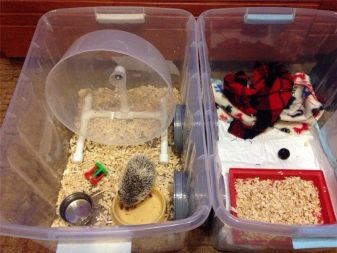
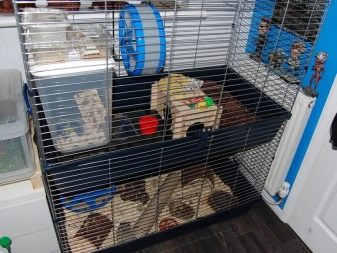
Proper care
Caring for a hedgehog, whether it is a decorative beast or a true inhabitant of the forest, requires that at home the pet feels about the same as in the wild. Maintenance procedures and maintenance rules are simple.
- Outside hedgehog overcomes huge distances every night in search of food and if you take away such an opportunity from him, he will probably gain weight, which will not end with anything good for the animal. Given that the cage in any case is not too large, it is necessary to purchase a running wheel, but not quite the same as for rodents. Remember that the hedgehog does not see well and any irregularities are dangerous for it, so instead of the rods, the wheel should have a solid surface in which the paws cannot get stuck.
It is necessary to choose the diameter of the wheel so that the spine of the beast does not bend when running.
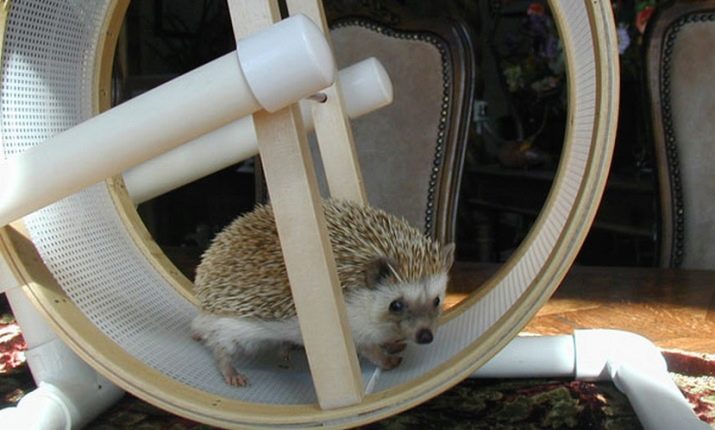
- The food bowl should be wide and firm, the edges rounded. This beast does not belong to the most tidy eaters, it fumbles during the process of eating, therefore a tall and thin vessel will be overturned every time. It is better to choose a nipple type drinking bowl, otherwise a needle companion will necessarily pour sawdust into the water.

- A cage in itself is not home to a hedgehog - this animal in nature seeks shelter more seriously and wants to have it also in the apartment.Theoretically, even improvised things can be used for these needs - an old and soft travel bag will fit, or you can sew a special bag of fleece.
In principle, any such thing is suitable, provided that it damps extraneous noise well and does not transmit light.
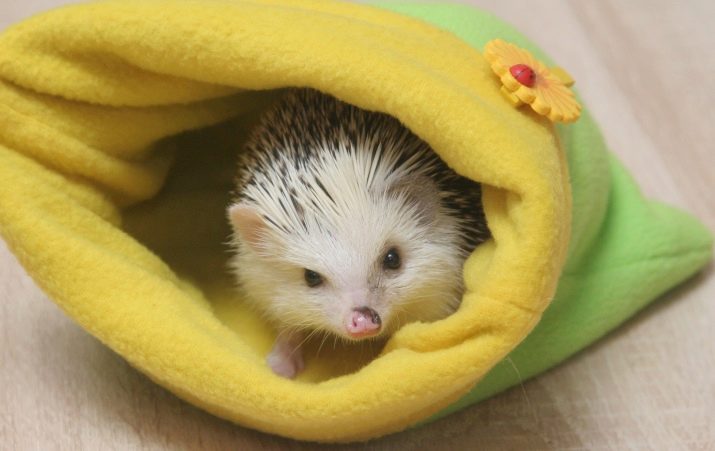
- The hedgehogs are playful enough which means that they need toys to entertain themselves in their free time. The beast will always be happy with something that can be rolled around the cage, because hedgehogs often get balls manufactured for cats, and even cardboard rods on which toilet paper is wound. As an alternative (or a good addition), a box with pieces of chopped fleece will fit - hedgehogs like to rummage in such junk and relax there.
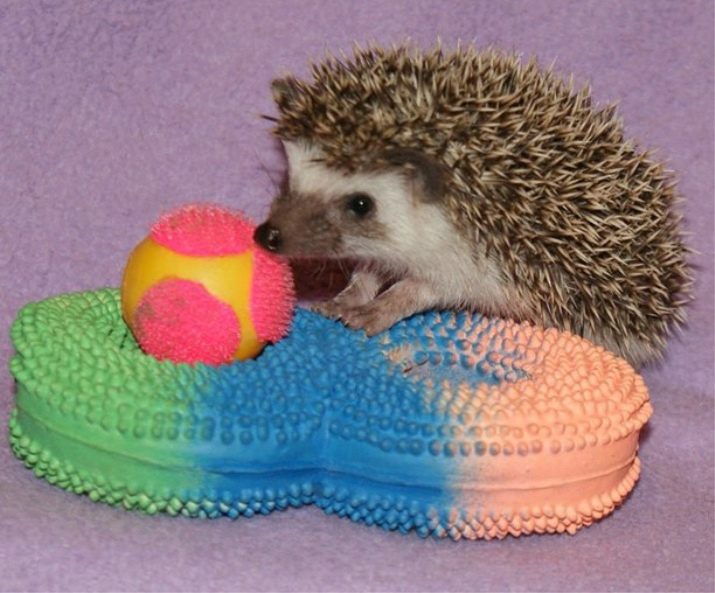
- To maintain sanitary conditions inside the cage, the pallet is filled with sawdust, special paper granules or cat litter. It is important to clarify that softwood filings as a filler are not categorically suitable: the fact is that when they come in contact with hedgehog urine, they react with it and emit fumes, which can have a very negative effect on the health of the pet.
In addition, you should not buy flavored artificial fillers: no one can predict the reaction of the animal to an unfamiliar smell.
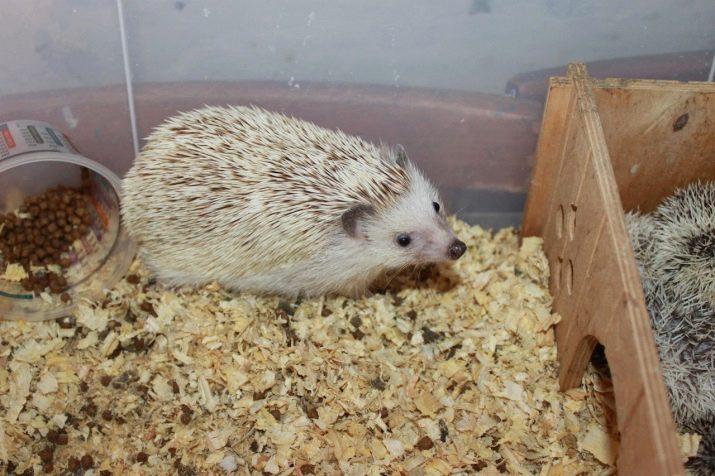
- The ideal temperature for an active home hedgehog ranges from 22-26 degrees. In fact, the beast, of course, can withstand a much wider range of temperatures, but in the heat it risks overheating, therefore it tries to hide in a cool shelter, and a significant cooling for a former forest resident is fraught with hibernation. For this reason, it is advisable to choose a place for the cage, remote from heating appliances and protected from direct sunlight.
With a sharp shutdown of the heating characteristic of the first spring heat, the pet may freeze - in this situation the forest "savage" will again hibernate, but the African, along with the dwelling, should be covered with a blanket so that he does not catch a cold.

- If you want to take care of the hedgehog correctly, give him the opportunity to walk outside the cage as well, but with great care. The beast is very curious and does not know the rules of behavior established by man, therefore it can easily damage furniture and even electrical wiring, not to mention decorative plants. In addition, in a large apartment he can easily find another "home" for himself, and, having lost sight of him, the owners may never find a pet during the day, until he starts stomping his paws and sniffing at night.

- You can’t walk with a hedgehog along the street, but you can equip an aviary for him directly on the balcony, remembering that direct sunlight is harmful. You can’t leave an African decorative hedgehog there for the winter, as it will simply freeze, but an ordinary forest animal will be able to “dig in” provided that you provide it with a sufficient amount of hay or straw.
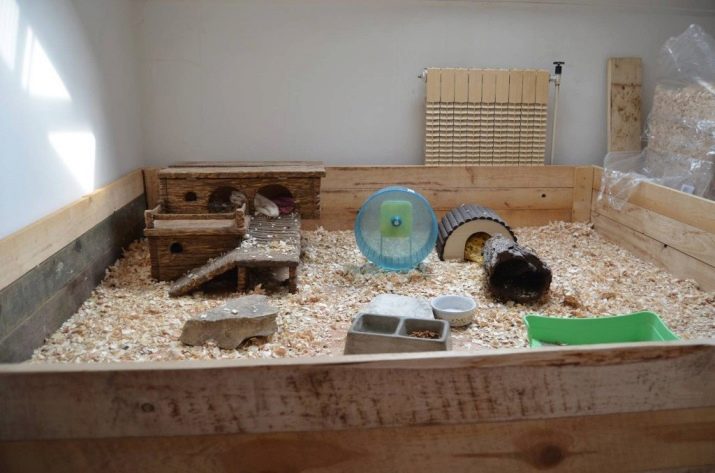
- Once every one or two months, it is advisable to bathe the hedgehog in relatively warm water with a temperature not exceeding 35 degrees. If you organize the process correctly, the pet will not resist. The animal must be carefully watered with water so that it does not fall into either the ears or the sly muzzle.
The needles are cleaned with a soft toothbrush; hypoallergenic soft shampoos without any bright odor are used as an aid.
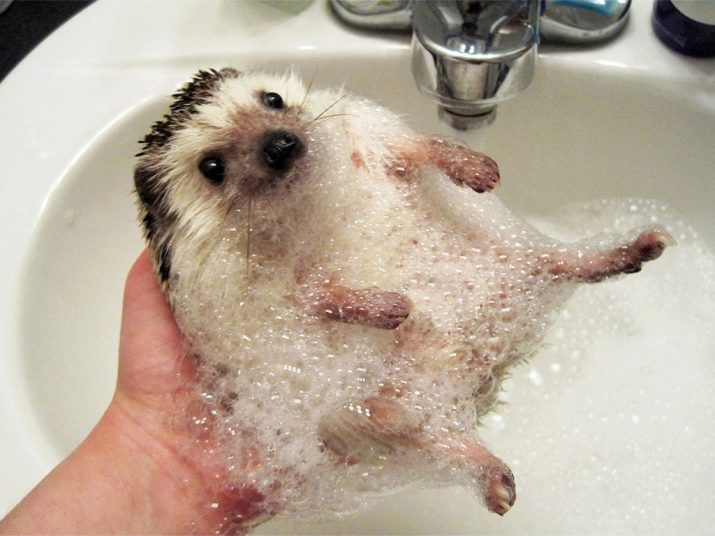
- You need to wipe the bathed baby dry. Experts also advise moisturizing his skin with natural oils based on coconut, apricot or even olives. In addition, it is after bathing that it is most convenient to cut the hedgehog's claws - under the influence of water and soap, they soften, so the procedure causes less discomfort.


Feeding Features
All experts are unanimous in the opinion that the hedgehog is very unpretentious in food and theoretically could eat a lot of things.Another thing is that the owners are usually interested in the health of their pet, therefore they must select an adequate diet containing a large amount of protein and fat. For this reason, domestic tetrapods are often fed. boiled meat or liver, as well as low-cost minced meat from offal.
You may have heard that hedgehogs love milk - this is true, only you need to give it not in its pure form, but with bread soaked in it. Although in reality these animals do not carry vegetables and fruits on their needles, as is often shown in the figures, they, of course, also eat them - apples and various berries are the most popular, and ordinary carrots will also work. In the wild, hedgehogs for obvious reasons do not eat either seafood or fish, and yet the pet will not even refuse such a treat, especially since it can be very useful for him in terms of the content of useful substances.



However, most owners of these animals do not particularly experiment, preferring to feed their pet about the same, but predictably healthy food. The average daily diet of a hedgehog is approximately 300 g of fish and 200 g of minced meat mixed with cereal. These products are divided in such a way as to be issued to the animal twice. For obvious reasons, the amount of food varies, depending on how large your instance is.
At the same time, do not forget to include in the diet the other products described above to diversify the vitamins and minerals that enter the body of the pet.
A hedgehog is not a creature that will eat to the dump, even if it no longer climbs into it, so it is difficult to overfeed it. Another thing is that uneaten food, remaining in a cell in a layer of sawdust, can be an ideal medium for the reproduction of various parasites, which can hardly be considered a good consequence. Hence, hedge servings should be calculated so that the four-legged one is able to eat everything at once.
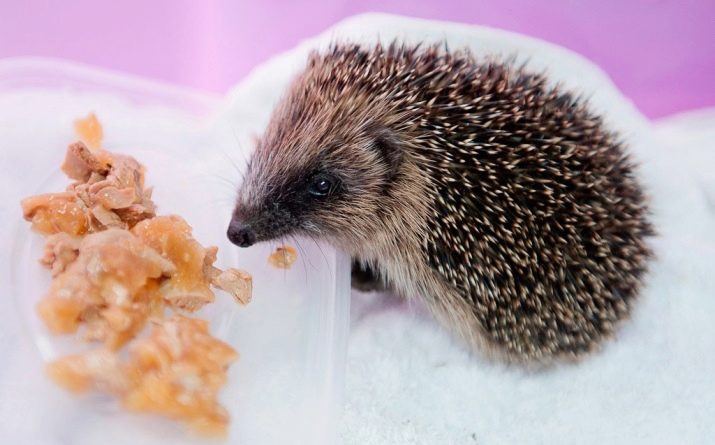
Hibernation
African dwarf hedgehogs do not fall asleep for the winter, but you will have to suffer with ordinary forest animals - even if you create good conditions for activity throughout the year, you won’t deceive nature. In nature, the beast before going to bed tries to gain maximum mass, it becomes more and more lethargic, which indicates the approach of cold weather.
Unable to eat during sleep, the baby loses weight significantly during the winter, which means that with the onset of autumn, you must increase the feeding rate for your pet without sparing food. Given the danger of lack of hibernation, you yourself must help to make the atmosphere feel cool - for this purpose, the hedgehog is often taken out to the balcony for the winter. With this attitude, the beast will sleep through the winter, if you find a cool place in the apartment, hibernation will be reduced to a maximum of one and a half to two months.
You should not worry about the health of your pet - it is normal for him to winter in the conditions of the street, so rely on his ability to build a normal nest for himself. To ensure that there is no problem with the latter, provide the hedgehog with a sufficient amount of building materials - the same fleece shreds, as well as dried grass, twigs and much more, are well suited for this role.
During sleep, do not disturb the animal - let it wake up when it sees fit.
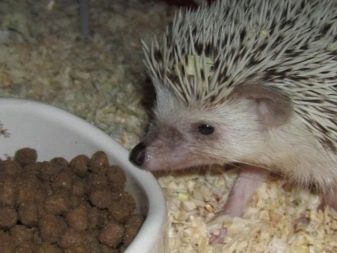

On how to care for hedgehogs at home, see the next video.










